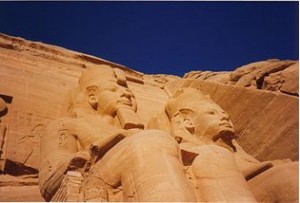Abu Simbel in Upper Egypt was saved from the rising waters of Lake Nasser, which accumulated behind the Aswan High Dam in a massive archaeological rescue plan sponsored by UNESCO in 1960. The temple complex dedicated to the Pharaoh Ramses II "the Great" is an unforgettable destination to perform in Egypt.
Abu Simbel is a village located 280 km south of Aswan and only 40 km north of the Sudanese border. It is a very small town with very little chance to attract visitors other than its great temples for which it is famous. Few tourists linger more than a few hours, even if there are 5 hotels to attract visitors to stay overnight.
The temples of Abu Simbel were formerly located further down the hill, facing the Nile, in the same relative positions, but due to the rising waters of Lake Nasser, the original locations are under water. In the 1960s, each temple was carefully sawed into numbered stone cubes, moved up, and reassembled before the water arrives.
The temples of Abu Simbel were formerly located further down the hill, facing the Nile, in the same relative positions, but due to the rising waters of Lake Nasser, the original locations are under water. In the 1960s, each temple was carefully sawed into numbered stone cubes, moved up, and reassembled before the water arrives.
The Great Temple of Ramses II was recovered in front of a fake mountain, built like a basketball dome, where the cubic stone occupies a section under the dome from the outside, the mountain looks like fake rock solid.
Archaeologists have concluded that the immense size statues in the Great Temple were intended to scare potential enemies approaching the southern region of Egypt, as they traveled on the Nile from Africa.
What you will see in Abu Simbel
Great Temple of Ramses II. visit from 06:00 to 17:00. Carved on a mountain between 1274BC and 1244BC, but lost to the world until it was rediscovered in 1813 by the Swiss explorer Jean Louis Burkhart. Dedicated to Ramses II himself and the gods Ra, Amun and Ptah. Features 4 statues of Ramses over 20m. Its axis was placed by the ancient Egyptian architects so that twice a year, in February and October 20th, the sun's rays penetrate the sanctuary and illuminate the sculpture on the wall, except for the statue of Ptah, the God who is always kept in the dark.




0 comments :
Post a Comment